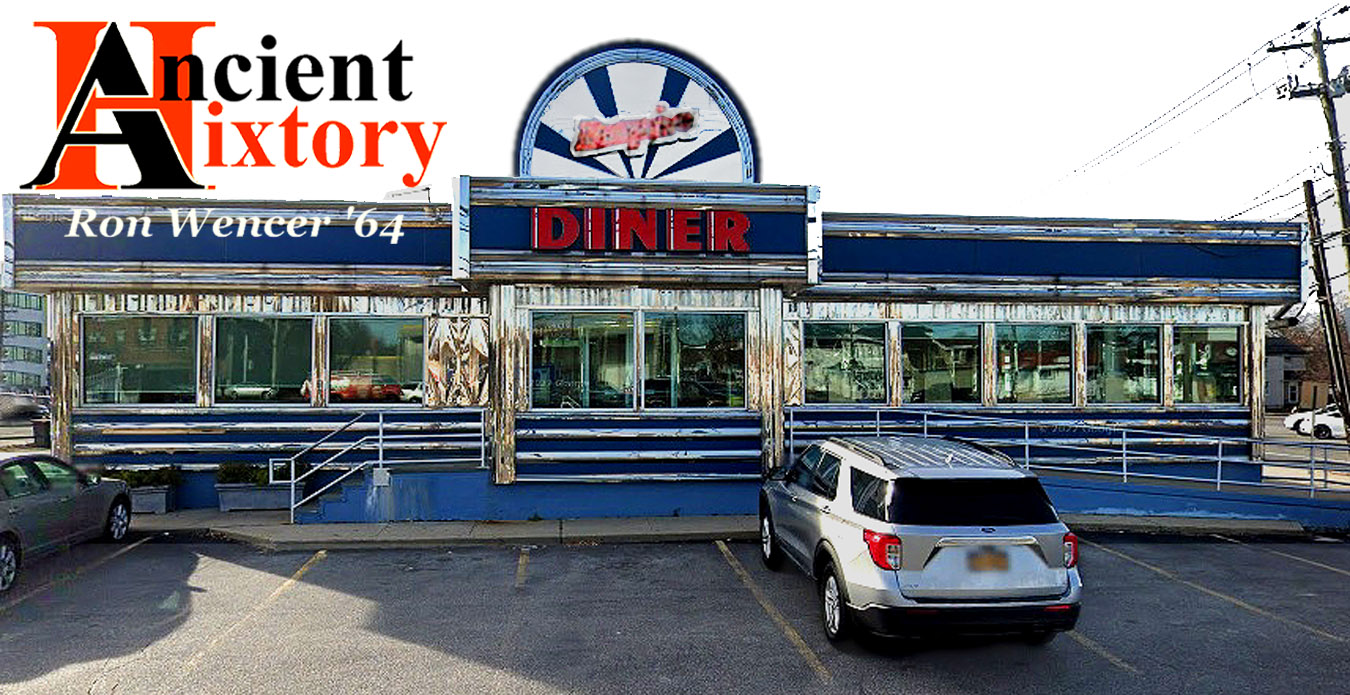 Introduction
Introduction
July’s Ancient Hixtory discussed the Hub Diner on East Marie Street, which appears to have been the first “dining car” eatery in Hicksville. That was nearly a century ago. In contrast, the latest incarnation of Hicksville’s Empire Diner is shown above. While this article is not going to cover the entire 90-odd years since the Hub began, it should get us, at least superficially, through the 1930s and 1940s, and then use the Empire as a lens for looking at the fast-changing world of 1950s Hicksville.
Now, back to the Hub Diner for a moment. Pete Foster, HHS Class of 1957, has shared with me some first-hand memories of a few local diners, for which I’m very grateful. He told me that John Dounelis, son of the owners of the Hub, was a member of his graduating class. Pete also mentioned that he and his late wife, Alice Davidson (HHS Class of 1959), first met in the youth program at Trinity Lutheran Church on Nicholai St. Later on, after attending services at the Church on Sundays, they would go out to eat nearby, not at the Hub, but at the Empire Diner.
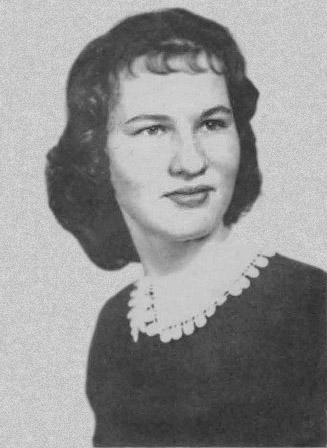 Alice Davidson, 1959
Alice Davidson, 1959 Pete Foster, 1957
Pete Foster, 1957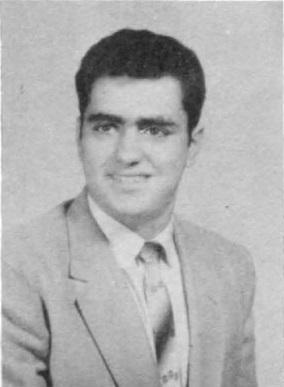 John Dounelis, 1957
John Dounelis, 1957For downtown 1950s Hicksville to have boasted two diners less than a quarter mile apart may seem odd to you, but consider this: there actually were THREE diners in the neighborhood. At that time, the Broadway Diner stood about 100 yards north of the Empire. Let’s look at how the local “dinerscape” had evolved after the Hub got going.
The Thirties and Forties
Because of the Great Depression, the 1930s were difficult for restaurants everywhere. Some elegant high-end spots survived – like the poor, the ultra-wealthy we will always have with us – but when the stock markets crashed, many lower and middle class families, and also many nouveau riche, instantly lost whatever wealth they thought they had. Compared to upscale restaurants, diners had a better chance of survival, as long as local manufacturing did not shut down – but not every diner, or every diner owner, would be able to stay in business.
In Hicksville, the Hub Diner kept going. After leaving his native Lesbos, future owner Harry Dounelis had first settled in Brookline, Mass. In the Greek immigrant community there, he learned all he could about running an American diner. Saving his earnings, and networking with other Greeks in the Northeast, he eventually found his opportunity in Hicksville. The location chosen for the Hub guaranteed a flow of movie patrons and firemen, two groups whose patronage would continue, albeit sometimes at reduced levels, even during the worst depths of the Depression.
In contrast, let’s consider the Hicksville Grill, at 32 Broadway. Never heard of it? Well, look at the red circle in this illustration, which shows the west side of Broadway, including the Triangle:
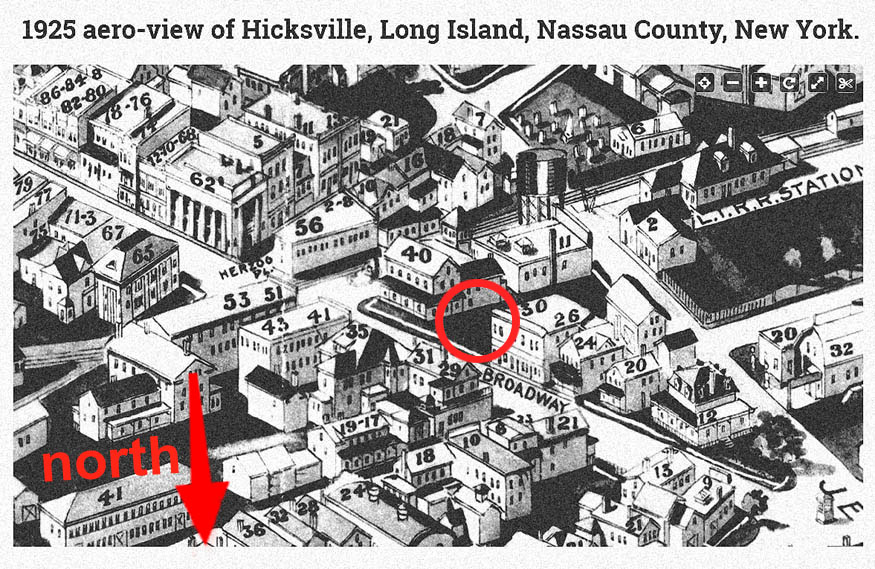
| Listing for 32 Broadway by Year(s) | |
| Hicksville Grill | 1929 - 1932 |
| John Diner | 1934 |
| Village Diner | 1935 - 1936 |
| Hicksville Diner | 1941 - 1944 |
| Empire Diner | 1948 - 1951 |
The circled empty space is where there soon would be a 32 Broadway. I do not know with certainty if a building was constructed on the lot, or if someone just “planted” a dining car there. I suspect that there was a building, one that blended in with the neighborhood, for had it been a dining car, I would remember seeing it when I lived in Hicksville. Incidentally, I know about the existence of 32 Broadway only from entries in old annual telephone books, as shown in the table here.
It appears that, from the Great Depression through the Korean conflict, many people went to 32 Broadway to eat. The frequent changes in business names, however, suggest that the owners of these eateries did not want to remain in business at that location.
In contrast, a prosperous wartime industry meant thousands of new employees who had to eat; new diners sprouted around the edges of industrial complexes. For example, the Halfway and Rainbow diners respectively served employees who used different gates on the vast Grumman property. Post-war, the local population was ballooning; the future of Hicksville’s diners looked good indeed.
The Empire Diner
As far as I can tell, the Empire’s original principal owner was Archie Kyriacou, an immigrant from Cyprus who actively promoted his business. In the late 1940s, when Hicksville resumed organized community sports after a hiatus during the war years, the Empire Diner softball team was often the best in the league. The diner earned praise from the Hicksville Sportsmen’s Club for its ongoing support.
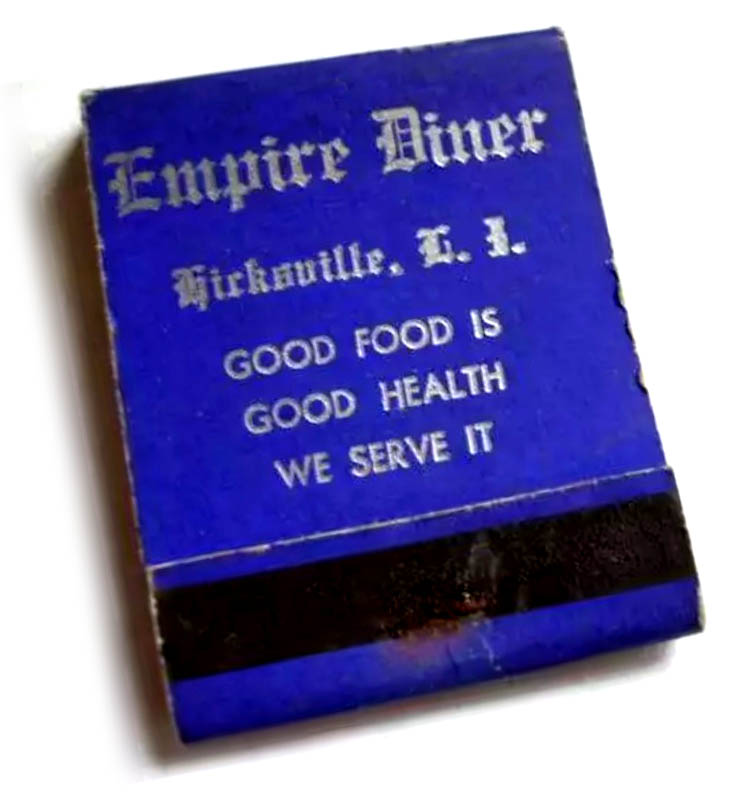
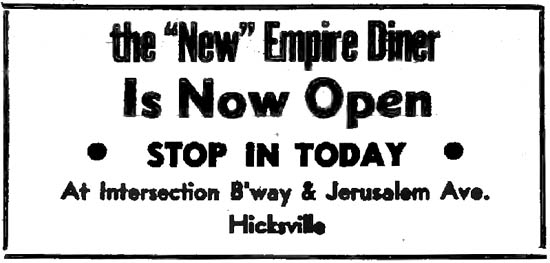 Kyriacou decided to upgrade his Empire in 1951. That May, newspapers announced that the diner would soon be getting a new “wagon” (i.e., pre-fabricated diner), which would be set down between Jerusalem Avenue and Broadway. The Triangle had seen many changes since that old Aero-View illustration was drawn in 1925. The big house at 12 Broadway was gone, as was the adjacent house at 20 Broadway. A Sunoco gas station now occupied the “point” at John Street, and behind it was a vacant lot. Come September, a new Empire Diner would open on that lot.
Kyriacou decided to upgrade his Empire in 1951. That May, newspapers announced that the diner would soon be getting a new “wagon” (i.e., pre-fabricated diner), which would be set down between Jerusalem Avenue and Broadway. The Triangle had seen many changes since that old Aero-View illustration was drawn in 1925. The big house at 12 Broadway was gone, as was the adjacent house at 20 Broadway. A Sunoco gas station now occupied the “point” at John Street, and behind it was a vacant lot. Come September, a new Empire Diner would open on that lot.
I remember seeing the Empire at that location in 1954 or 1955, and I thought it looked great (of course, I was only about 8 at the time). Although I think that Archie Kyriacou would have agreed with me, I also think that he was more concerned with its location than its looks. The new Empire offered easy access and parking to motorists. It was visible at a distance to drivers coming south on North Broadway. Just to make certain they noticed it, the illuminated words EMPIRE DINER “hovered” above the gas station, supported by a thin, graceful framework that was firmly planted on the diner property (see below). The Empire’s future at its new address seemed guaranteed.
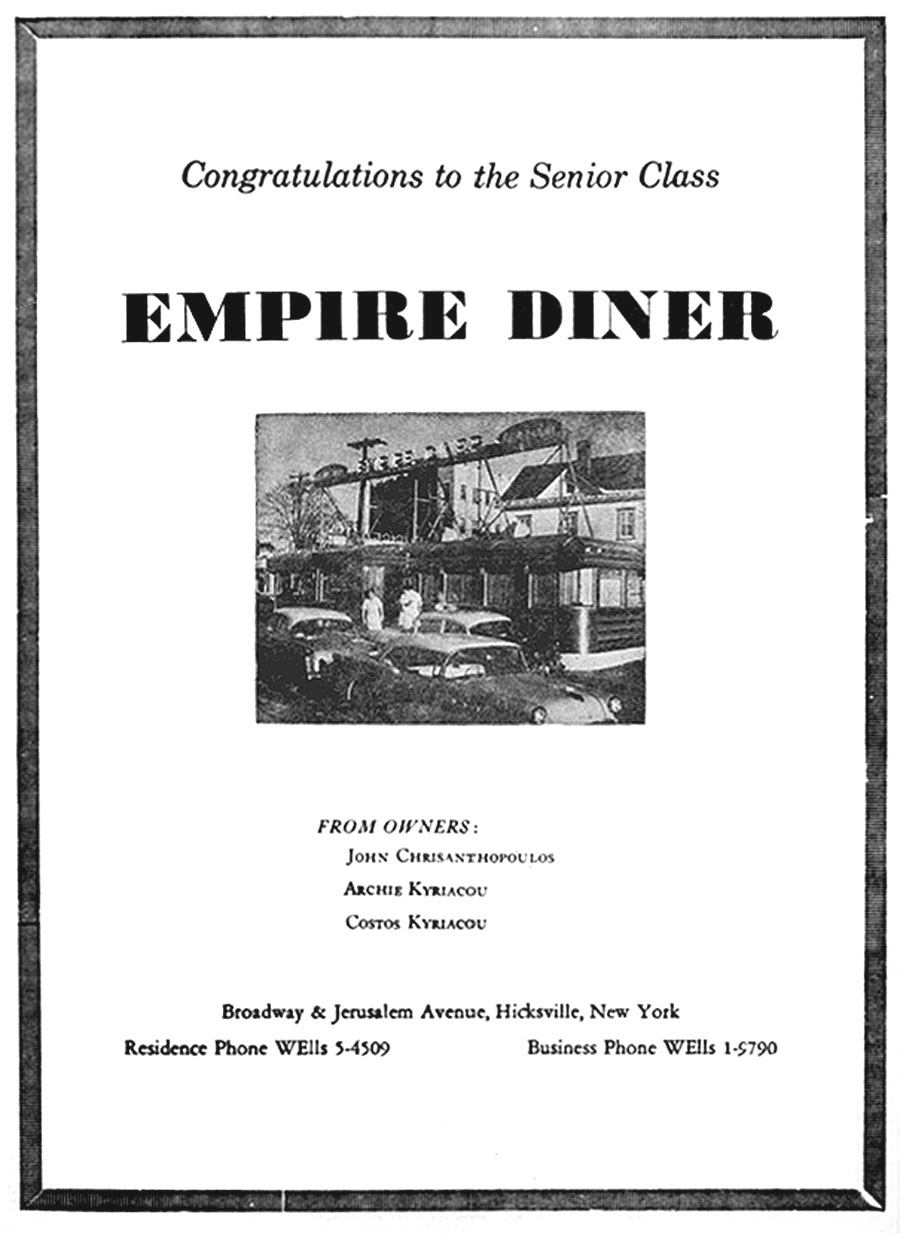 A reminder: If you click on this ad from the 1957 Comet Yearbook, a larger image will pop open on your screen. Note the Hicksville Professional Building in the background, across Broadway and to the south of the diner. Immediately behind the diner is 24 Broadway, an older house by then subdivided into multiple living quarters.
A reminder: If you click on this ad from the 1957 Comet Yearbook, a larger image will pop open on your screen. Note the Hicksville Professional Building in the background, across Broadway and to the south of the diner. Immediately behind the diner is 24 Broadway, an older house by then subdivided into multiple living quarters.
Foreshadowing the Destruction of 1967
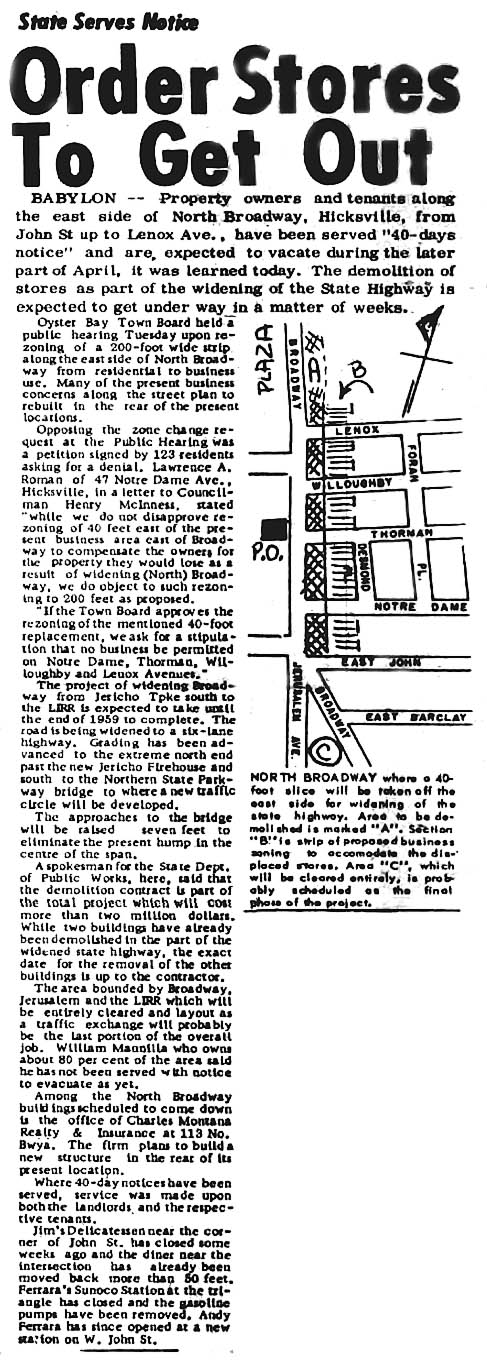 For years, the local Businessmen’s Association had fretted about the inevitable elimination of Hicksville’s grade-level crossings with the LIRR tracks. Eventually, it received verbal assurances that when the grade crossings were eliminated, the affected local roads would not be submerged in open cuts, cutting off automobile access to local stores.
For years, the local Businessmen’s Association had fretted about the inevitable elimination of Hicksville’s grade-level crossings with the LIRR tracks. Eventually, it received verbal assurances that when the grade crossings were eliminated, the affected local roads would not be submerged in open cuts, cutting off automobile access to local stores.
Unfortunately, the Association had worried about the wrong thing. In 1956, the Mid-Island Herald published an article about the possibility that, between the LIRR tracks and Old Country Road, buildings on the west side of Broadway might someday be demolished. As alarming as this would be, the article also had news of something that was certain: NYS had taken control of North Broadway. Because of sharply increased traffic attracted by the Mid-Island Plaza, Albany had decided to turn it into a six-lane road, all the way from Jericho Turnpike to the tracks at Hicksville Station. Many buildings would likely be demolished.
Archie K. would have been worried – yes, his diner could be moved if necessary, but no other lot in downtown Hicksville offered the same advantages the Empire enjoyed.
In late March 1958, the same newspaper published the final details.
Many businesses would have to leave; others – like the Broadway Diner at East John and North Broadway – might be able to stay, provided they could move further “inland” from Broadway. For the Empire, the news could not have been worse – the Triangle now was State land, and Albany wanted to flatten everything that stood on it. The Empire would have to move to an inferior location.
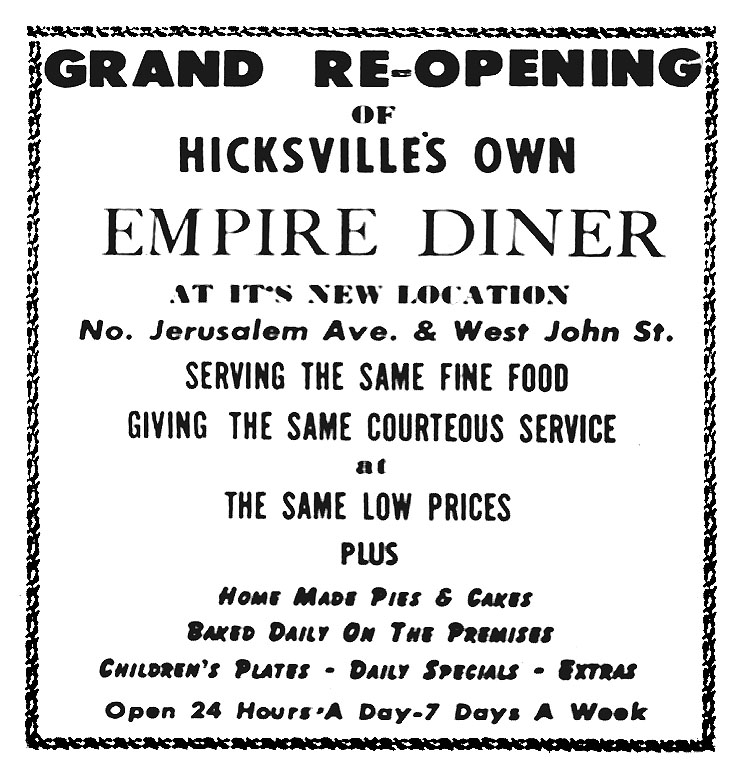 In the end, the Empire’s owner(s) did the best they could, and moved the diner across Jerusalem Avenue and around the corner to West John Street.
In the end, the Empire’s owner(s) did the best they could, and moved the diner across Jerusalem Avenue and around the corner to West John Street.
Moving to the new location felt like a step backward. A vacant house (which Kyriacou was not able to purchase as part of the new diner site, because it was tied up in probate) stood on the corner; the house and its foliage effectively screened the diner from passing traffic. Navigating the crazy intersection of John Street, Jerusalem Avenue, and Broadway during rush hours was not for the faint of heart. As time went by, the empty house on the corner became more of an eyesore. Archie Kyriacou’s frustration simmered, and a lot would happen as a result -- too much to fit into this article. His story will continue next time.
Until then, CIAO!
Appendix: List of Images and Their Sources
1. Empire Diner Today
Google Maps Streetview 2022 (modified by author)
2. Hicksville High School Graduation Photos
Hicksville Public Library’s History Archives
http://history.hicksvillelibrary.org/yearbook
1957, 1958 Comet Yearbooks
3. 1925 aero-view of Hicksville, Long Island, Nassau County, New York (excerpt)
Library of Congress Digital Collections
https://www.loc.gov/item/75694782/
4. Empire Diner Matchbook c.1950
ebay.com
5. “New” Empire Diner is Now Open
NYS Historic Newspapers, Mid-Island Herald, September 12, 1951
nyshistoricnewspapers.org
6. Congratulations to the Senior Class (advertisement for Empire Diner)
http://history.hicksvillelibrary.org/yearbook
1957 Comet Yearbook
7. Order Stores to Get Out
NYS Historic Newspapers, Mid-Island Herald, March 27, 1958
nyshistoricnewspapers.org
8. Grand Re-Opening
NYS Historic Newspapers, Mid-Island Herald, December 18, 1958
nyshistoricnewspapers.org

